2009 VOLKSWAGEN GOLF seat adjustment
[x] Cancel search: seat adjustmentPage 159 of 516
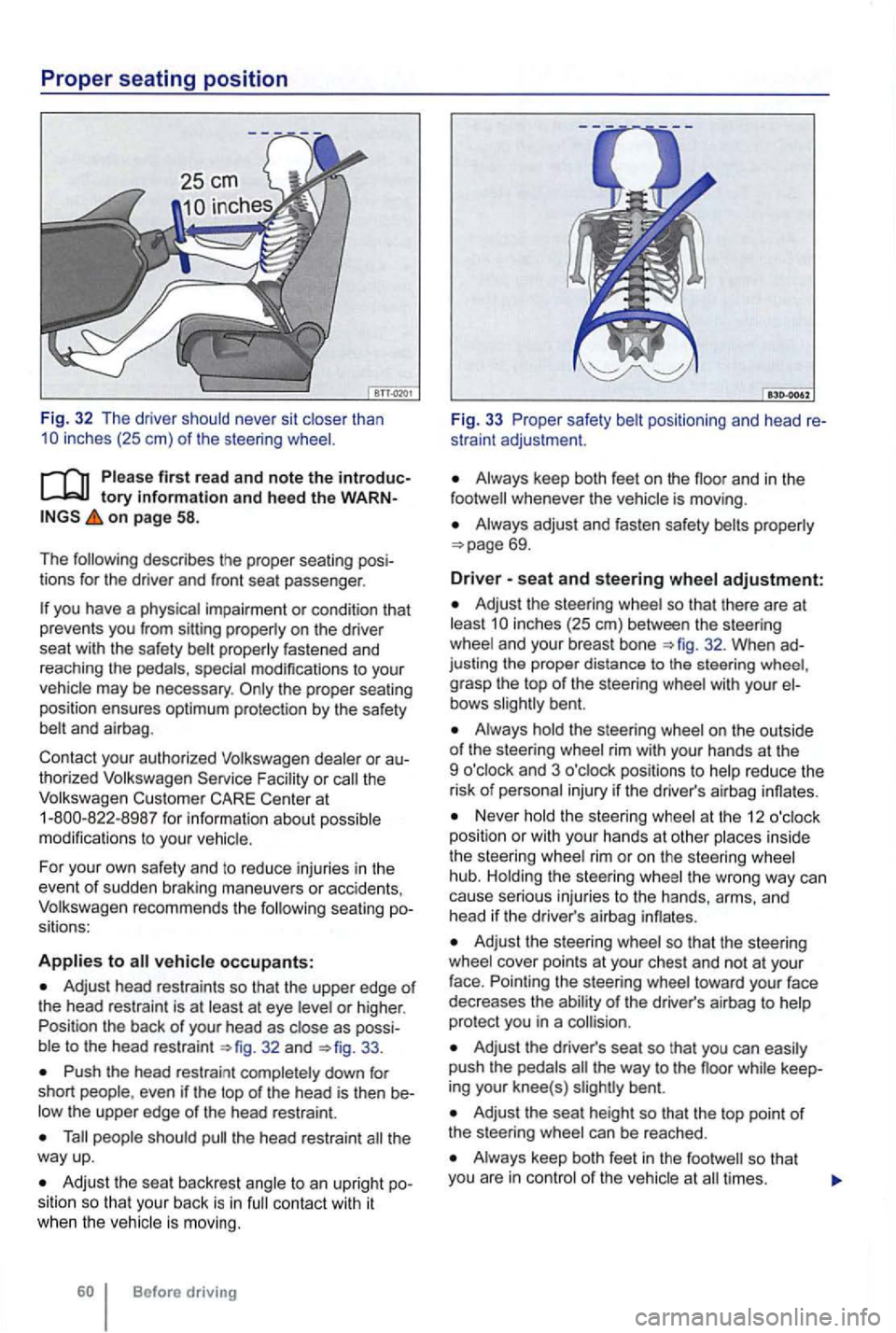
first rea d and note the introductory information and hee d the WARNon page 58.
The following describes the proper seating posi
tions for the driver and front seat passenger .
special modifications to your
vehicle may be necessary .
to
Adjust head restraints so that the upper edge of the head restraint is at least at eye
32 and 33.
Push the head restrai nt completely down for
short even if the top of the head is then be
people should the head restraint the way up.
Adjust the sea t backrest angle to an upright position so that your back is in contact with it when the veh icle is moving.
Before driving
Fig. 33 P roper safety
Always keep both feet on the whenever the vehicle is moving .
Always adjust and fasten safety belts properly
adjustment:
Adjust the steering whe el so that there are at least inches (25 em) between the steeri ng
wheel and your breast bone
grasp the top of the steering wheel with your bent.
Always hold the steering wheel on the outside of the steering wheel rim with your hands at the
9 o'clock and 3 o'clock positions to help reduce the
risk
of personal injury if the driver's airbag innates.
Never hold the steering wheel at the 12
and
head if th e driver's airbag innates.
Adjust the steering wheel so that the steering
wheel cover points at your chest and not at your
face. Pointing the steer ing wheel toward your face
dec reases the ability
of the driver's airbag to help
protec t you in a
Adjust the driver's seat so tha t you can easily push the pedals the way to the noor while keep
ing your knee(s) bent.
Adjust the seat height so that the top point o f
the steering wheel can be reached .
Always keep both feet in the times.
Page 160 of 516
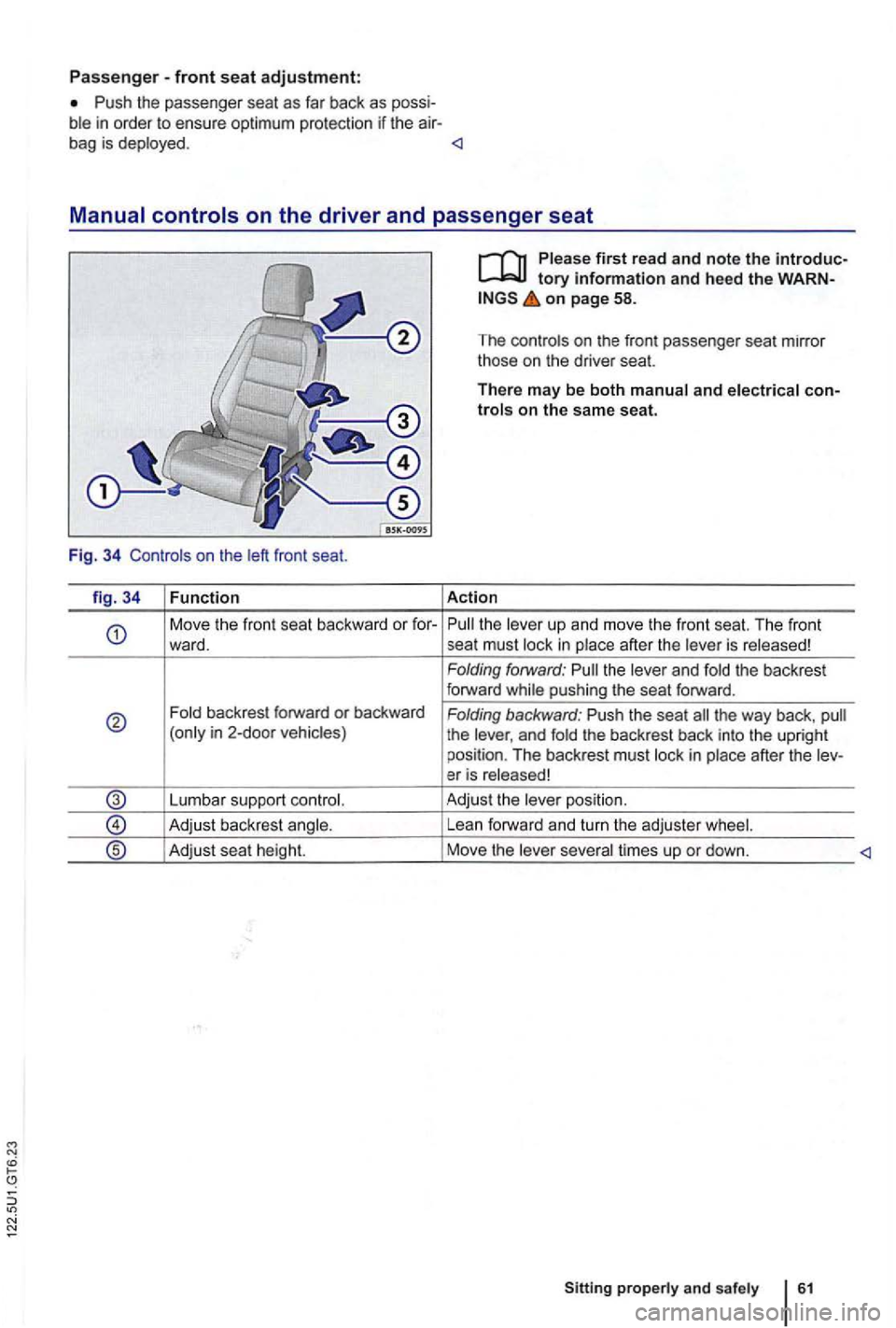
N
N
Passenger-front seat adjustment:
P ush the passe nger seat as far back as possi
M ove the front seat backward or for-ward.
Fold backrest forward o r backwa rd
(only in 2-door vehicles)
Lumbar support contro l.
Adjust back rest angle .
Adjust seat height.
on page 58.
The contr o ls on the fr on t passenger seat mirror
those on the
driver seat.
There may be both manual and electrical con
in place after the leve r is released!
Folding forwar d: Pull the
the way back , p ull
t he lever , a nd fold the back res t back into the upright
p osit
ion . The backrest must in place after the le v-
er is released!
Adj ust the leve r position.
Lea n forward and tu
rn th e adjuster wheel.
Move the lever
times up o r down .
Sitting properly and
safely
Page 161 of 516
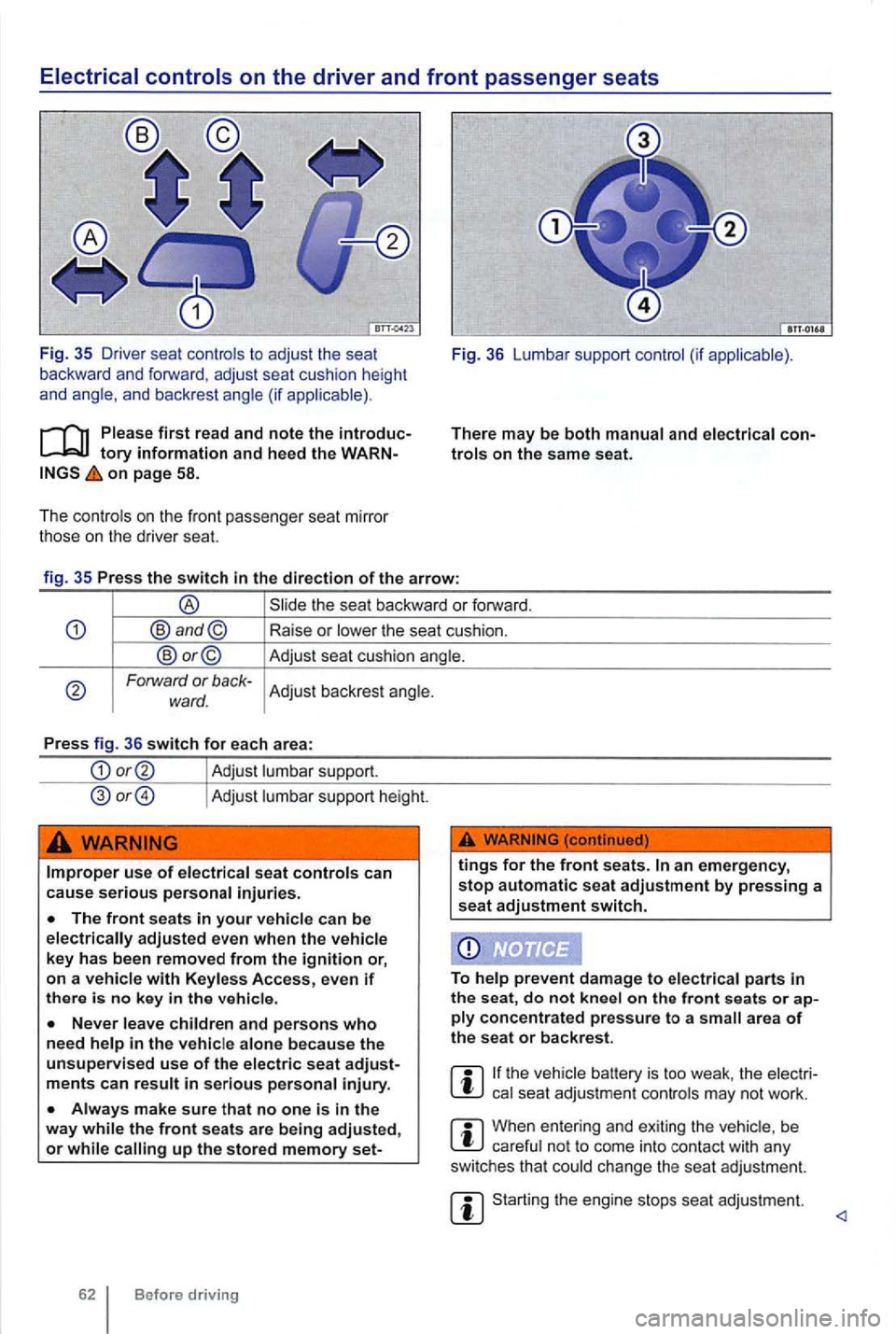
on page 58.
The cont rols on the front passenger seat mirro r
those on the driver seat. Fig
. 36 Lumbar support control (if app licable) .
There
may be both manual and elect rical
Forward or back-Adjust backrest angle. ward.
Press fig. 36 switch for each area:
Adjust lumbar support.
Adjust lumbar support height.
Improper use of electrical seat controls can cause serious personal injuries.
up the stored memory set-
tings for the front seats.
on ply concentrated pressure to a area of the seat or backrest.
the vehicle battery is too weak , the elect rical seat adjustment controls may not work .
When entering and exiting the vehicle , be careful not to come into contact with any
switches that could change the seat adjustment.
Starting the engine stops seat adjustment.
Page 166 of 516
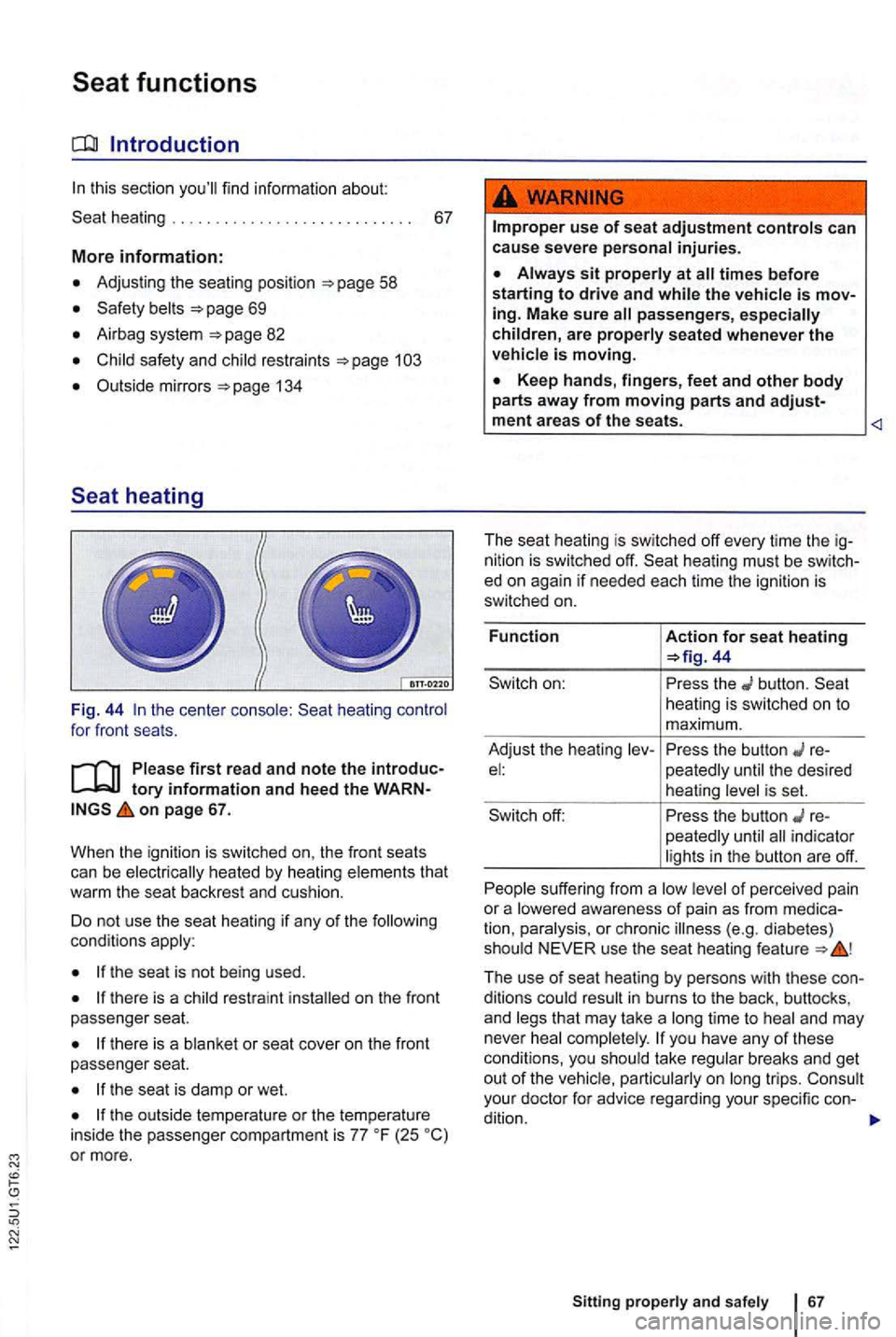
this section find information about:
. . . 67
More information:
Adjusting the seating position 58
69
Airbag system page 82
safety and restraints
Outside mirrors 134
the cente r heating for front seats.
on page 67.
When the igni
tion is sw itched on, the front seats
can be that
wa rm the seat backrest and cush ion .
Do not use the seat heating
if any of the cond itions
the sea t is not being used.
on the front
passenger seat.
there is a or seat cover on the front
passenger seat.
the seat is damp or wet.
(25 or more .
use of seat adjustment controls can
cause severe personal injuries.
passengers, especially
children, are properly seated whenever the
44
button. heating is sw itched on to
m aximum.
Adjust the hea ting
re-the desired
heating
the button re
peatedly indicator
s uff ering from a of perce ived pain
or a
The use of seat heating by persons with these conditions time to and may
never
take breaks and get out of the trips. your docto r fo r advice rega rding your specific con-
dition.
Sitting a nd 67
Page 190 of 516
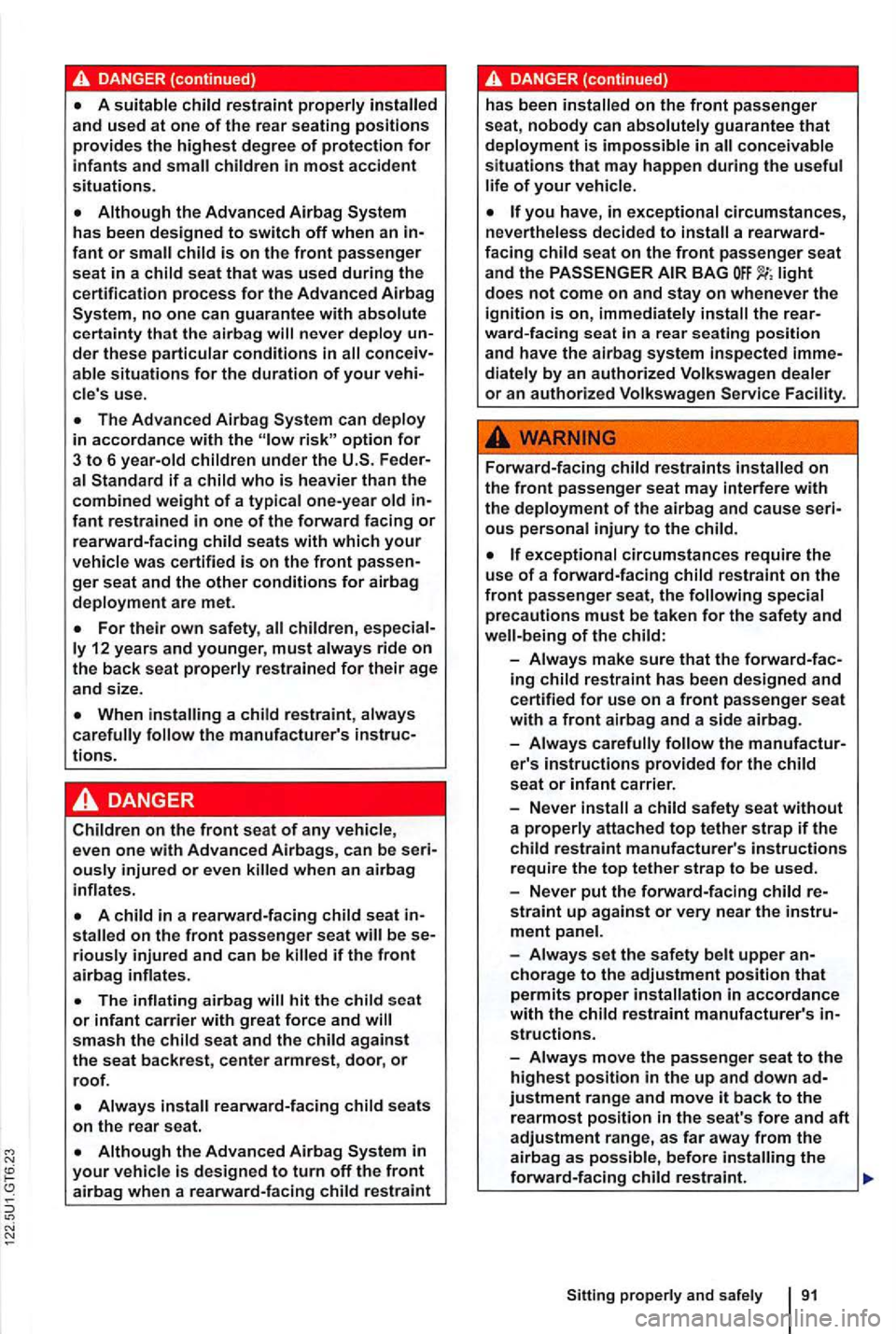
no one can guarantee with absolute certainty that the airbag never deploy
can deploy in accordance with the option for 3 to 6 year-old children under the if a child who is heavier than the combined weight of a typical one-year old fant restrained in one of the forward facing or rearward-facing seats with which your vehicle was certified is on the front passenger seat and the other conditions for airbag deployment are met.
on the front passenger seat if the front airbag inflates.
smash the child seat and the child against the seat backrest, center armrest, door, or roof.
conceivable situations that may happen during the useful life of your vehicle.
light does not come on and stay on whenever the ignition is on, immediately
ous personal injury to the child.
exceptional circumstances require the use of a forward-facing child restraint on the front passenger seat, the following special precautions must be taken for the safety and of the child:
-Always make sure that the forward-facing child restraint has been designed and certified for use on a front passenger seat with a front airbag and a side airbag.
-
Always carefully the manufacturer's instructions provided for the child seat or infant carrier.
- Never
straint up against or very near the instrument panel.
-
Always set the safety belt upper chorage to the adjustment position that permits proper installation in accordance with the child restraint manufacturer's
Sitting properly and safely 91
Page 203 of 516

vehicle occupants and children must be restrained properly whenever riding in a veh icle . An unrestrained or improperly restra ined child could be injured by striking the interior or by being ejected from the vehicle during a sudden maneuver or impact. An unrestrained or improperly restrain
ed child is also at greater risk of injury or death through contact with an inflating air
bag .
and used at one of the rear seating positions provides the highest degree of protection for infants and
exceptional circumstances require the use of a forward-facing child restraint on the front passenger's seat, the
the manufacturer's instructions provided with the child seat or infant carrier.
- Never
a child restraint without a properly attached top tether strap if the
child r estraint manufacturer' s instructions
r equire the top tether strap to be used.
- Never
put the forward-facing r e straint up ag ainst or very near the instrument
-Always set the s afety belt upper anchorage to the adjustment position that p ermits proper in accordance with the
- Always move the passenger seat to the highest position in the up and down adjustment range and move it back to the rearmost position in the seat's fore and aft adjustment range , as far away from the airbag as possible before
GER BAG light comes on and stays on
light does not come on and stay on, immediately the forward-facing child seat in a
rear seating position and have the airbag
system inspe cted by your authorized
Volkswagen dealer or authorized Volkswa
gen
Always read and heed
=>page 69, belts, =>page 82, Airbag system and =>page
Alwa ys rep lace r est rai nt s that were installed in a veh icle during a crash. Damage
to a c hil d res traint th at is not visible could cause it
to fa il in an ot her co llisio n situation.
on p age tha t comp lies with U nited Fede ra l Motor
Page 207 of 516
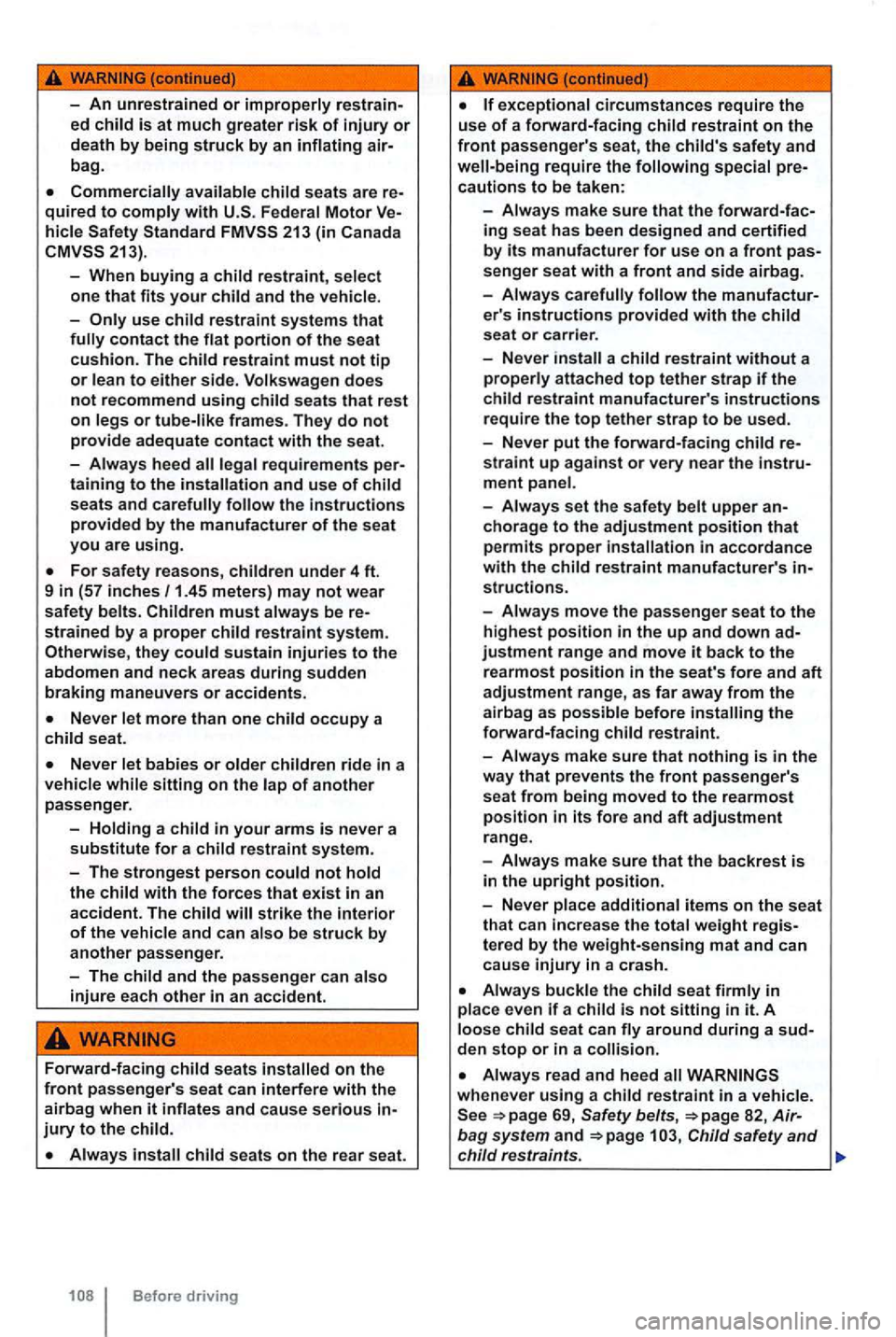
seats are re-quired to Motor Ve-
and the
restraint systems that
to either side. seats that rest on
seats and the instructions provided by the manufacturer of the seat you are using.
For safety reasons,
restrain t system. Otherwise, they sustain injuries to the abdomen and neck areas during sudden braking maneuvers or accidents.
occupy a
Never
a in your arms is never a substitute for a restraint system.
-The strongest person the strike the interior of the be struck by another passenger.
- The
injure each other in an accident.
Forward-facing on the front passenger's seat can interfere with the airbag when it and cause serious in-jury to the
seats on the rear seat.
(continued)
restraint on the front passenger's seat, the safety and
senger seat with a front and side airbag.
-
er's instructions provided with the seat or carrier.
- Never
a
straint up against or very near the
set the safety chorage to the adjustment position that permits proper
structions.
-
justment range and move it back to the rearmost position in the seat's fore and aft adjustment range, as far away from the airbag as
weight
even if a is not sitting in it. A around during a den stop or in a
restraint in a 82,
Page 212 of 516

straint up against or very near the instrument
-set the safety chorage to the adjustment position that permits proper restraint manufacturer's structions.
-
move the passenger seat to the highest position in the up and down justment range and move it back to the rearmost position in the seat's fore and aft adjustment range, as far away from the airbag as before res traint.
-
weight r egistered by the weigh t-sensing mat and cause injury in a crash.
- Make
sure that the GER BAG the time whenever the ignition is switched on.
-
thorized Volksw agen or authorized
Volksw ag en S ervice Facility.
the seat in even if a is not sitting in it. A around during a sud-
den stop or in a
A with the universa l a n chorages or with the standard safety on the rear seat
may with unuse d r ear seat safet y
injury and even death .
secure unused rear seat safety out of reach of
restraint is
Never activate the switchable re-
trac tor when routing the safety around the head restraints .
Never anyone sit at the center rear
seating position if t he center rear safety
When a res traint, be
not to activate the switchable retractor when routing the safety
out far enough to you to route the around th e head restraint.